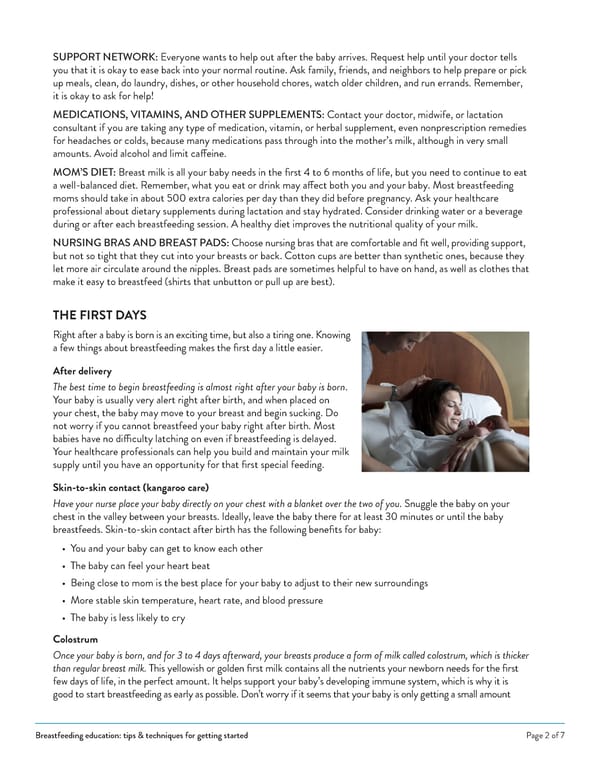SUPPORT NETWORK: Everyone wants to help out after the baby arrives. Request help until your doctor tells you that it is okay to ease back into your normal routine. Ask family, friends, and neighbors to help prepare or pick up meals, clean, do laundry, dishes, or other household chores, watch older children, and run errands. Remember, it is okay to ask for help! MEDICATIONS, VITAMINS, AND OTHER SUPPLEMENTS: Contact your doctor, midwife, or lactation consultant if you are taking any type of medication, vitamin, or herbal supplement, even nonprescription remedies for headaches or colds, because many medications pass through into the mother’s milk, although in very small amounts. Avoid alcohol and limit caffeine. MOM’S DIET: Breast milk is all your baby needs in the first 4 to 6 months of life, but you need to continue to eat a well-balanced diet. Remember, what you eat or drink may affect both you and your baby. Most breastfeeding moms should take in about 500 extra calories per day than they did before pregnancy. Ask your healthcare professional about dietary supplements during lactation and stay hydrated. Consider drinking water or a beverage during or after each breastfeeding session. A healthy diet improves the nutritional quality of your milk. NURSING BRAS AND BREAST PADS: Choose nursing bras that are comfortable and fit well, providing support, but not so tight that they cut into your breasts or back. Cotton cups are better than synthetic ones, because they let more air circulate around the nipples. Breast pads are sometimes helpful to have on hand, as well as clothes that make it easy to breastfeed (shirts that unbutton or pull up are best). THE FIRST DAYS Right after a baby is born is an exciting time, but also a tiring one. Knowing a few things about breastfeeding makes the first day a little easier. After delivery The best time to begin breastfeeding is almost right after your baby is born. Your baby is usually very alert right after birth, and when placed on your chest, the baby may move to your breast and begin sucking. Do not worry if you cannot breastfeed your baby right after birth. Most babies have no difÏculty latching on even if breastfeeding is delayed. Your healthcare professionals can help you build and maintain your milk supply until you have an opportunity for that first special feeding. Skin-to-skin contact (kangaroo care) Have your nurse place your baby directly on your chest with a blanket over the two of you. Snuggle the baby on your chest in the valley between your breasts. Ideally, leave the baby there for at least 30 minutes or until the baby breastfeeds. Skin-to-skin contact after birth has the following benefits for baby: • You and your baby can get to know each other • The baby can feel your heart beat • Being close to mom is the best place for your baby to adjust to their new surroundings • More stable skin temperature, heart rate, and blood pressure • The baby is less likely to cry Colostrum Once your baby is born, and for 3 to 4 days afterward, your breasts produce a form of milk called colostrum, which is thicker than regular breast milk. This yellowish or golden first milk contains all the nutrients your newborn needs for the first few days of life, in the perfect amount. It helps support your baby’s developing immune system, which is why it is good to start breastfeeding as early as possible. Don’t worry if it seems that your baby is only getting a small amount Breastfeeding education: tips & techniques for getting started Page 2 of 7
 Breastfeeding education: tips & techniques for getting started Page 1 Page 3
Breastfeeding education: tips & techniques for getting started Page 1 Page 3